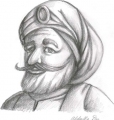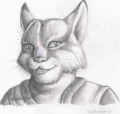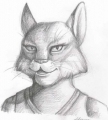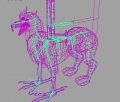Chris Warren, Stijn van Empel
Anonymous Game Developer Interactive
First posted on 07 September 2008. Last updated on 06 April 2012.
All images are courtesy of AGD Interactive © 2008.
This article is posted in collaboration with HebrewQuest.
About the site
HebrewQuest is a Hebrew adventure game site founded by Jonathan Yalon.
For more information, visit HebrewQuest.
About the game
Quest for Glory II is fan remake of Quest for Glory II: Trial by Fire originally developed and published in 1990 by Sierra On-Line.
A limited edition 23"x31" Quest for Glory II poster is also available for free with the purchase of the Collector's Edition of Al Emmo and the Lost Dutchman's Mine. The posters are cinema stock quality and are available in very limited numbers as a rare collector's item.
For more information, visit Quest for Glory II: Trial by Fire by AGD Interactive.
AGD Interactive (Anonymous Game Developer Interactive or AGDI) is a name that is likely familiar to both the adventure gaming community and the indie game development scene. The group, formerly known as Tierra Entertainment (a parody of Sierra Entertainment), is best known for releasing 2 highly acclaimed fan remakes of King's Quest games—King's Quest I VGA and King's Quest II+ VGA. The same group, under the label Himalaya Studios, is also the developer of Al Emmo and the Lost Dutchman's Mine—a commercial adventure game based on a brand new IP rather than an existing licensed work. In August 2008, the group has finally released, after nearly 8 years in development, its third remake—Quest for Glory II. The game aims to be a faithful fan remake of the popular adventure/role-playing hybrid classic Quest for Glory II: Trial by Fire. As with previous releases, the game is available free for download from the AGD Interactive website.
We are privileged to have an opportunity to interview 2 members of the AGD Interactive team who are responsible for the development of the Quest for Glory II remake: Chris "Anonymous Game Creator 2" Warren (project director, programmer, and animator) and Stijn "Erpy" van Empel (programmer and combat system designer). Usually shy from public attention (part of the motto of AGD Interactive), Warren and van Empel speak to us in great detail about the complex development of this remake, the feedback they have received from Lori Ann and Corey Cole (the creators of Quest for Glory) about their fan game, and their philosophy on both indie and commercial game development. They also reflect on the triumphs and disappointments they have with the release of Al Emmo and the Lost Dutchman's Mine.
Check out our exclusive photos of the AGD Interactive team (including photos from the team's trip to Oakhurst in 2005 to meet the game's original creators) as well as our gallery of production art and screenshots from Quest for Glory II!
- The first question is perhaps most obvious: why have you chosen to take such an active role in this project, your third non-profit remake?
- In actual fact, Quest for Glory II was the very first remake project I (Chris) started back in late 2000. I started working on it some months before we had any notion of doing a King's Quest I or King's Quest II remake, and certainly long before we had any ideas about creating commercial adventure game titles. Due to the complexity of this remake however, its development phase has outlasted all of our other games, which have admittedly been simpler affairs. So, while the Quest for Glory II remake was indeed released as our 3rd non-profit remake, this wasn't really an intended or planned course of action. Once we started it, we just wanted to get it finished and released regardless of which order it came out. As things turned out, we had to fulfill our commercial obligations toward Himalaya Studios and Al Emmo first, and that took priority for most of 2005-2006. Prior to that, we needed to build our skill with AGS in order to acquire the experience necessary to actually program all the complexities of the Quest for Glory II remake. The King's Quest remakes gave us that experience.
- Can you tell us a little bit about the project's history, especially about the last years that have appeared to be very busy for the members of the development team?
- The Quest for Glory II remake was started as a one-man project in 2000, even before King's Quest I VGA was released. A prototype of the game was made at that time, consisting of the main Shapeir areas without any alleyways connecting them. The hero could walk around, but that was pretty much it. The development didn't truly start up again until after King's Quest II+'s voice pack was released in 2003. In addition to Chris doing the directing, animating and scripting, Britney doing the character portraits and some of the close-up art and Tom doing the music, Stijn was taken on board as a scripter and several artists who were previously unaffiliated with the team contributed their talents to the game. The development stage of the game, during which all the art was made, all the scenes were scripted, the dialog system and alleyway system were designed by Adam and everything was put together lasted until 2005, after which we had a game that was completely playable from the beginning until the end, but was very unrefined. From 2005 until 2008, the refinement stage of the game was in process which was all about touching up rough-looking art and particularly fixing literally dozens upon dozens of bugs.
The development stage of a game, especially the start, is always inspiring and exciting. It's like moving into a new house. When new backgrounds, sprites, scenes, and music get posted every few days, it's easy to remain motivated. And you can often easily tell how much progress remains until all of the backgrounds, sprites, and scenes are done. The refinement stage is the polar opposite, particularly with the Quest for Glory II remake. No new materials or assets come in anymore, it involved only monotonous chores such as adjusting minor alleyway decorations by a few pixels, waiting for a monster to pull off that bug-inducing move at the bug-inducing moment, and generally playing through the game until it seems stable and you can find no more bugs. There's literally no end in sight until you actually get there, which isn't just difficult on motivation at times, but the non-transparent nature of the process is also difficult for fans to deal with as a short timeline is generally anticipated once the game gets into the beta testing stage. Unfortunately, the time required in beta testing can vary widely. The Quest for Glory II remake was expected to spend no more than 2 months in testing, but this ended up being 7 months, due to the complexity and multitude of the bugs encountered. We eventually started posting samples of out beta testing bug reports in the public forums to show fans we were still working on the game, but we couldn't give an actual time schedule until we were very near to the finish line when we knew for certain that no more delays would take place and the release was imminent.
- Quest for Glory II offers lots of interface and graphical improvements, but unlike King's Quest II+ VGA, it's more of a "1 to 1" remake—the style and the story are exactly the same. Why have you chosen to stay so true to the original game spirit in this case?
- The original King's Quest II by Sierra was a very basic "treasure hunt" with sometimes obscure puzzles blocking the way to your goal and little to no interaction with NPC's. It was very good in its day, but it didn't really have much of a story... just a mission you had to accomplish with puzzles along the way. The original Quest for Glory II, on the other hand, was already written as a rich and well-defined game world. Each NPC already had his or her own unique personality and lines about just about every subject you could think to ask them about. Changing this would be taking away original material (and high quality original material at that). We didn't feel like QFG2 needed such a major story overhaul... the plot was delivered well and the story unfolded like a good story should.
That said, we did go out of our way to enhance certain things that made the original such a fun experience to play. Battle is much more sophisticated now, the option to tell NPC's about subjects is no longer merely used to solve certain puzzles with but is also used for fun and character development, and there are more mini-events and Easter Eggs/Silly Clowns to entertain the player. All-in-all, we've tried to enhance whatever we could about the game without touching the already well-written and well-designed plot.
- How did you manage to keep the members of the development team working voluntarily?
- Commitment is a lot harder to find than talent. We've had good luck in the sense that the people who've joined our team are all committed individuals who are not afraid to drop out of normal life and commit every free second of their day to make the game's final release a reality. Motivation breeds motivation in a team and in order to keep morale high, it's important for all members to keep working hard to finish their assigned tasks, as visual progress inspires other members to remain involved and focused. However, it also takes a certain type of person to successfully complete a fan game and if you have a person on your team who remains working hard even after the initial enthusiasm wears off and even though you're not always around to hold their hand, then you know you're working with someone who has the personality of a fan-game developer. Getting people to work without pay is difficult, but motivation and a common goal and interest in classic Sierra games pushes everyone on our team to succeed.
- In my interview with Lori Ann Cole, the lead designer of the original Quest for Glory games, she seemed to encourage your work. You once met Lori and her husband/partner Corey in person. What feedback did you get from them?
- Meeting with the Coles was definitely a dream come true for us. Lori showed us around Oakhurst and had tons of stories to share. We were also privileged enough through some of the original design documents of the Quest for Glory games and managed to pull together some scrapped material to implement a new mini-game. Lori and Corey were very encouraging to the idea of following our dreams and I'd say our visit with them has certainly inspired and motivated us to see the Quest for Glory II remake through to the end. Particularly, since at that moment, the hard part of the development phase was just starting.
- Being in the works for so many years, your numerous project updates have made some Quest for Glory fans both enthusiastic and temperamental (most exceptionally in the last days before the release). What is your PR strategy and do you have second thoughts about your "when it's done" answer?
- It has been a policy of AGD Interactive to somewhat avoid a lot of publicity until we have something to show. King's Quest I VGA was never announced until the moment that it was ready for release. Since game development typically always takes much longer than you estimate at first (no matter how much time you plan in for unexpected delays) it's almost unavoidable that every release date you predict will be overshot. Even our development team did not fully grasp the immensity of the task we had taken upon ourselves until we were right in the middle of it. We understand that fans interpret "when it's done" as "stop asking", but nothing is more discouraging to fans than a promise you can't live up to. Because of that, we prefer to be very reserved with promises on the whole. We certainly don't regret the many times we used the "when it's done" answer, because trite and overused as it may be, it's also the most honest answer you can provide and the least likely to disappoint.
- How many people have downloaded the King's Quest I VGA and King's Quest II+ VGA remakes so far? And how many people do you expect to download Quest for Glory II?
- To date, the approximate download figures for each game are:
King's Quest I VGA: downloaded 412,054 times.
King's Quest II+ VGA: downloaded 451,313 times.
As I type this, Quest for Glory II has been out a little over four days, and we are rapidly approaching the 25,000 downloads mark. I can't say how many times I expect it to be downloaded, but I can presume that it will probably receive somewhere around the same amount of downloads as the King's Quest remakes before it.
- There are still many Sierra classics that many fans will love to see remade (e.g., Space Quest, Leisure Suit Larry, The Colonel's Bequest, Gold Rush!, and more). Have you thought about creating a fourth Sierra remake?
- At this stage, we really can't afford to. Creating free games takes an immense amount of time and energy and is very hard to do when you're not generating any profit – particularly when you also have to fund the games from your own pocket. And while we do like the idea of remaking more Sierra games, we sadly can't continue doing remakes forever unless it were a paid job.
I believe that there also comes a point where remaking too many high-quality free games causes damage to the commercial adventure genre as a whole, because if people know that they can get a continuous stream of high quality adventures for free, made by people who work on them for nothing, then what kind of message does it send to publishers and consumers alike? It sets somewhat of a precedent that these games are not financially worthy of the amount of time and effort put into them. But we as adventure fans all know that nothing could be further from the truth! We now feel that we have reached the pinnacle of what we can do at AGDI and that we should next move onto creating new commercial adventures at Himalaya Studios. We have a few loose ends to tie up at AGDI however, and will be recompiling the two King's Quest remakes with a more recent build of the AGS engine and fixing some bugs in the process.
- Your commercial game, Al Emmo and The Lost Dutchman's Mine, received positive reviews (including a review from the New York Times) but perhaps did not justify itself financially. How would this affect your commercial phase (and how many units did the game sell, if you could reveal this detail)?
- I don't believe we're making the sales statistics for Al Emmo public. At least, not just yet. But, no, it doesn't mean the end for Himalaya Studios. It has been a setback that we've had to recover from, but we do already have a concept for another new original commercial game in mind. It's still early days yet, so there's not much point in speculating further on it at this juncture. Suffice to say that we'll be catering to fan feedback that we have received since the release of Al Emmo.
- Adventure Game Studio, though definitely the most popular game engine used in the independent adventure game development scene, is limited to creating classic 2D games. Have you considered using another game engine for your future projects?
- AGS does have the capability to produce 2.5D adventure games (3D character models over a 2D background) with custom plug-ins, but certainly isn't optimized for this kind of thing. We haven't really considered all of our options for future commercial games yet. But we are very familiar with the AGS engine now, so it remains the best choice for a speedy development process. Additionally, the more 3D we go, the further we get from the "classic" niche we're trying to fill. I guess time will tell.
- Thank you very much for a wonderful remake of a wonderful game, and keep up the good job!
- Thanks for the opportunity and the compliments!



















